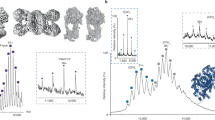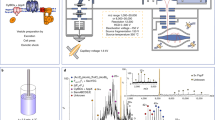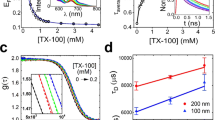Abstract
Although freeze-fracture electron microscopy is normally analysed with the presumption that particles represent proteins embedded within the membrane, particles which appeared to represent inverted lipid micelles within membranes have been reported1–4. I have now confirmed the occurrence of particles in protein-free liposomes, but have found that they behave like intermembrane attachment sites rather than structures within a membrane.
This is a preview of subscription content, access via your institution
Access options
Subscribe to this journal
Receive 51 print issues and online access
$199.00 per year
only $3.90 per issue
Buy this article
- Purchase on Springer Link
- Instant access to full article PDF
Prices may be subject to local taxes which are calculated during checkout
Similar content being viewed by others
References
Verkleij, A. J., Mombers, C., Leunissen-Bijvelt, J. & Ververgaert, P. J. J. Th. Nature 279, 162–163 (1979).
DeKruijff, B. et al. Biochim. biophys. Acta 555, 200–209 (1979).
Verkleij, A. J., Mombers, C., Gerritsen, W. J., Leunissen-Bijvelt, L. & Cullis, P. R. Biochim. biophys. Acta 555, 358–361 (1979).
De Kruijff, B., Cullis, P. R. & Verkleij, A. J. Trends biol. Sci. 5, 79–81 (1980).
Author information
Authors and Affiliations
Rights and permissions
About this article
Cite this article
Miller, R. Do ‘lipidic particles’ represent intermembrane attachment sites?. Nature 287, 166–167 (1980). https://doi.org/10.1038/287166a0
Received:
Accepted:
Issue Date:
DOI: https://doi.org/10.1038/287166a0
This article is cited by
-
Syncytial coupling of neurons in tissue culture and early ontogenesis
Neuroscience and Behavioral Physiology (2008)
-
Morphology and viscoelasticity of bilayer aqueous colloids of low-molecular and macromolecular amphiphiles
Colloid & Polymer Science (1989)
-
Polymorphic behavior of gram-negative bacteria membranes
The Journal of Membrane Biology (1987)
-
Structural and functional consequences of galactolipids on thylakoid membrane organization
Journal of Bioenergetics and Biomembranes (1987)
-
Functional analysis of tight junction organization
Pfl�gers Archiv European Journal of Physiology (1985)
Comments
By submitting a comment you agree to abide by our Terms and Community Guidelines. If you find something abusive or that does not comply with our terms or guidelines please flag it as inappropriate.



